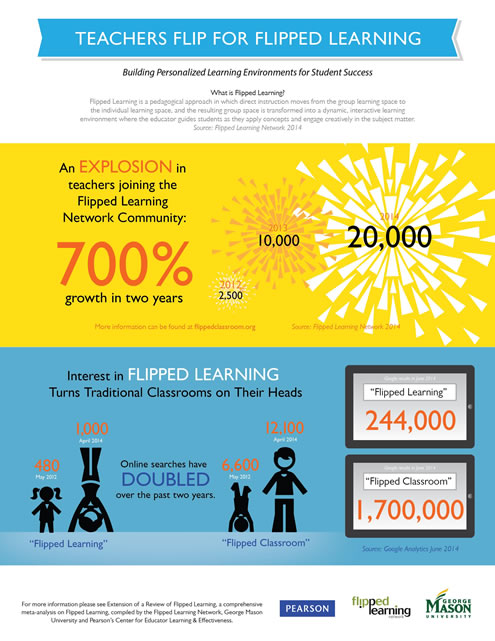Comprehensive research and case study analysis reveals 20 new facts about Flipped Learning
 As with all types of popular learning models that have the potential to be nothing more than a flash in the pan, it’s important to conduct thorough research on the model’s real potential. And according to a 2014 research and case study review, there are roughly 20 new things higher education faculty and leaders should know about Flipped Learning.
As with all types of popular learning models that have the potential to be nothing more than a flash in the pan, it’s important to conduct thorough research on the model’s real potential. And according to a 2014 research and case study review, there are roughly 20 new things higher education faculty and leaders should know about Flipped Learning.
The report, “2014: Extension of a Review of Flipped Learning,” conducted by George Mason University with the support of Pearson and the Flipped Learning Network (FLN), reviews current relevant research—both theory and empirical evidence—to learn more about Flipped Learning’s growth in education, and its effects on student learning faculty teaching.
“The team of collaborating researchers agrees that continued research and evaluation will be required, but current studies support the potential of the flipped learning model,” said co-author of the review and head of Pearson’s Center for Educator Learning & Effectiveness, Katherine McKnight. “The model focuses teachers on how they use instructional time, maximizing their use of learning activities both in and outside of the classroom. A number of well-designed studies testing the impact of the flipped model on student learning suggest a positive impact.”
(Next page: 20 new facts about Flipped Learning)
Please note that all statistics quoted, as well as in-depth methodology in each instance, can be found in the full report.
Growth:
1. The term ‘Flipped Learning’ was recognized by 96 percent of teachers, an increase from 74 percent two years prior when a similar study was conducted. The number of teachers who indicated they had flipped a lesson during the school year went up from 48 percent in 2012 to 78 percent in 2014. Of the teachers who do flip, 96 percent say they would recommend it to a colleague.
2. FLN’s community of practice, called Ning, has grown from 2,500 members in January 2012 to 10,000 on June 19, 2013 at the 6th annual conference, to more than 20,000 members as of May 29, 2014.
3. A search in Google in June 2014 resulted in 244,000 hits for the terms ‘Flipped Learning’ and 1,690,000 links for ‘flipped classroom.’ Using the same terms in Google Scholar, the number of hits resulted in 314 and 2,530, respectively.
Resources:
4. Recently, the FLN released the Four Pillars of F-L-I-P, but have also added 11 new indicators for educators to use as a self-assessment, or for administrators or coaches to use when guiding integration and implementation. Examples include:
- I provide students with different ways to learn content and demonstrate mastery.
- I give students opportunities to engage in meaningful activities without the teacher being central.
- I differentiate to make content accessible and relevant to all students.
- I conduct ongoing formative assessments during class time through observation and by recording data to inform future instruction.
For the full list of indicators, read the report.
How it’s used and by whom:
5. On average, 8 out of 10 flipped teachers have more than 6 years of experience teaching; 42 percent of ‘flippers’ have been teaching for 16 years or more.
6. While math and science classes were still flipped the most, there was a significant increase in English classes. In 2014, flipped teachers also reported using the method for social studies (18 percent), technology and computer sciences (17 percent) and world languages (7 percent).
7. 40 percent of administrators said they were interested in “trying Flipped Learning” this year.
Case study findings: (All methodology used by these institutions can be found in the report)
8. In a University of British Columbia study, students in the flipped section of a Quantum Mechanics class scored significantly better on the Concept Survey than the students not in the flipped section (85 percent versus 67 percent).
9. In the same UBC study, there was no difference in student retention.
10. The University of Memphis’ General Chemistry course found that students who took flipped sections of the course performed better in subsequent courses in that same subject.
11. At Texas A&M, despite an increase in student achievement after taking flipped health-nursing courses, students in the fully flipped sections were least satisfied with the courses; researchers attribute this to the perception of increased workload. However, in a Georgia Institute of Technology study, student attitudes towards the flipped format became increasingly positive over the course of the semester.
12. At Capitol University, the flipped model introduced new graded assignments, such as group homework, representing 20 percent of students’ grades, which may account for differences in final grades.
13. Flipped Learning was also applied to a graduate course at the University of North Carolina in the School of Pharmacy, and the average final exam scores increased significantly from 160.06 (out of 200 points) in 2011 to 165.48 in 2012.
14. In the same UNC study, self-reported attendance also increased compared to the previous semester, which researchers say suggests that the “fundamental elements of the Flipped Learning model were visible to students and that students recognized the positive impact they had.”
15. At Harvey Mudd College, after an extensive multi-year study on student achievement while using the flipped model for STEM courses, researchers found that “the question isn’t whether this model is or is not effective, but rather, under what conditions can it be most effective.”
Professional Development:
16. Many organizations outside of higher education are also using Flipped Learning. For example, in a consulting firm report released in 2014, out of 157 professional associations, 10 percent planned to use Flipped Classes for PD. The report predicts continued growth in the flipped model as people continue to feel strapped for time.
17. In a Center for Digital Education (CDE) report that surveyed 309 higher education faculty members, 56 percent of respondents reported that they were either currently implementing or planned to implement Flipped Learning for PD. 57 percent viewed the experience positively and 83 percent reported a positive change in their attitude toward teaching since flipping.
Technology most helpful:
18. Almost all educators say that videos improve the learning experience, stating that the videos have a positive impact on students’ satisfaction from the learning experience and that videos increase teacher satisfaction from their teaching experience.
Concerns:
19. The most common concerns about Flipped Learning are: student access at home, needed instruction on how to make or find high-quality videos, how to best use additional classroom time, and the time required to develop a flipped course.
20. Faculty at larger institutions believe that the concern over the time required to create a flipped course can be mitigated by including a graduate teaching assistant to help with the workload.
(Next page: Infographic)
[field name=graphic]
- 25 education trends for 2018 - January 1, 2018
- IT #1: 6 essential technologies on the higher ed horizon - December 27, 2017
- #3: 3 big ways today’s college students are different from just a decade ago - December 27, 2017


